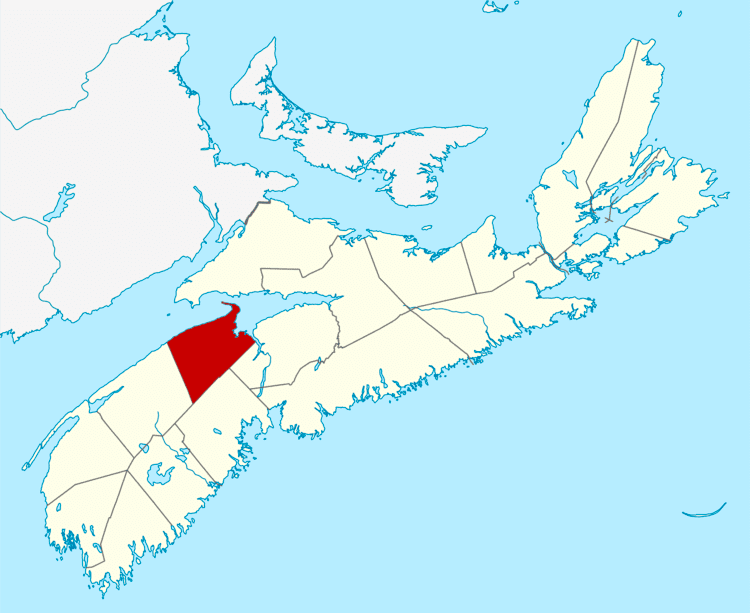Country Canada Incorporated April 17, 1879 Population 60,600 (2016) | Established August 17, 1759 Area 2,122 km² | |
 | ||
Colleges and Universities Acadia University, Kingston Bible College A, Kingston Bible College Points of interest Kings County Museum, Oaklawn Farm Zoo, Prescott House Museum, Apple Capital Museum, Grand‑Pré National Historic S | ||
Kings county nova scotia canada 14 real stories 2013
Kings County is a county in the Canadian province of Nova Scotia. It is in central Nova Scotia on the shore of the Bay of Fundy, with its northeastern part forming the western shore of the Minas Basin.
Contents
- Kings county nova scotia canada 14 real stories 2013
- Map of Kings County NS Canada
- History
- Demographics
- Notable people
- Communities
- Access routes
- References
Map of Kings County, NS, Canada
History
The first inhabitants of the coast, valley and interior of Kings County were the Mi'kmaq. Archaeological evidence from sites in the area indicate Mi'kmaq habitation dates back thousands of years. The Mi'kmaq were a semi-nomadic people who followed seasonal food sources. Their lives changed with the arrival of the Europeans.
The colonization of "Les Mines" and Grand Pre began in the 1680s when a few families relocated from the French settlement at Port Royal. These "Acadian" settlers were named after the French name for the land "Acadie" meaning "land of plenty". These farmers were accustomed to farming on dyked lands, and did so here as well. This took place on the normally salty but fertile marshes that were found on the banks of the Minas Basin, through the use of dykes and aboiteaux that allowed fresh water to enter but kept out the salt-water tide. The Acadian farmers prospered in Kings County, and lived harmoniously with the Mi'kmaq. The Acadians and Mi'kmaq jointly fought numerous battles against the British in the Raid on Grand Pre, Battle of Grand Pre, and the Siege of Grand Pre.
After defeat and expelling the Acadians, British control of the land was secured by repopulating the former French lands with settlers from New England. Between 1760 and 1768 some 8000 New England Planters arrived in Nova Scotia, the largest number settling in Kings County in three agricultural townships: Horton, Cornwallis, and Aylesford. The Planters revived and expanded the Acadian dykeland agriculture through projects such as the Wellington Dyke and cleared more upland fields, gradually moving west from the initial settlements along the Minas Basin Rivers. The legacy of the New England Planters is still a tangible part of the life in Kings County, and had an important influence on Nova Scotian ideas on democratic government, freedom of religion and equality of education.
The Planters were followed in the 1780s by further settlers from the United Empire Loyalists and significant numbers of Irish immigrants. The roots of Black Heritage in Kings County began almost 250 years ago when the New England Planters were accompanied by slaves and freed Blacks to settle in Horton and Cornwallis townships. This initial African population increased with larger migrations following the American Revolution and especially the War of 1812. Further waves of immigration followed in the following two centuries, adding to the population and diversity of Kings County.
The county's agricultural industry blossomed in the 19th century, especially after the arrival of the Dominion Atlantic Railway which led to a major expansion of exports, especially the apple industry. After the loss of the British export market for apples in World War II, Kings County farmers diversified into other crops and livestock. Agriculture remains a major industry, as the county has some of the best farmland in Nova Scotia, but farmland now faces pressure from suburban development around valley towns. The county also faces serious pollution problems in its major water artery, the Cornwallis River.
Kings County was a major wooden shipbuilding area in the 19th Century, including a four-masted barque built in Kingsport named Kings County which was one of the largest ever built in Canada. Today a number of light industrial factories are located in Coldbrook and Waterville.
The county's history is preserved and interpreted at the Kings County Museum in Kentville and a number of Kings County towns have museums related to their specific stories such as the Wolfville Historical Society and the Apple Capital Museum in Berwick.
Demographics
As a census division in the 2016 Census of Population conducted by Statistics Canada, Kings County recorded a population of 60,600 living in 25,951 of its 29,187 total private dwellings, a change of 5000000000000000000♠0% from its 2011 population of 60,589. With a land area of 2,126.71 km2 (821.13 sq mi), it had a population density of 28.5/km2 (73.8/sq mi) in 2016.
Forming the majority of the Kings County census division, the Municipality of the County of Kings recorded a population of 47,404 living in 20,108 of its 22,548 total private dwellings in the 2016 Census of Population, a change of 3000700000000000000♠−0.3% from its 2011 population of 47,569. With a land area of 2,094.05 km2 (808.52 sq mi), it had a population density of 22.6/km2 (58.6/sq mi) in 2016.
Notable people
Communities
Access routes
Highways and numbered routes that run through the county, including external routes that start or finish at the county limits:
